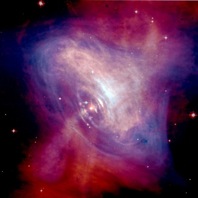|

Fingers and loops revealed in the Crab Nebula
BY DR EMILY BALDWIN
ASTRONOMY NOW
Posted: 07 November, 2008
The Chandra X-ray Observatory has captured the first clear view of the faint boundary of the Crab Nebula’s X-ray emitting pulsar wind nebula.
The Crab Nebula is located about 6,000 light years away in the constellation of Taurus and is powered by a rapidly rotating, highly magnetised neutron star, or pulsar (seen as a white dot near the centre of the image), the remnant of the gravitational collapse of a massive star that met its fate in a supernova explosion.

Chandra has captured a clear view of the faint boundary of the Crab Nebula’s X-ray emitting pulsar wind nebula. Image: NASA/CXC/SAO/F.Seward et al.
The Crab pulsar spins on its axis around 30 times a second, and this rapid rotation, combined with a strong magnetic field, generates an intense electromagnetic field that creates jets of radiation emanating from the poles of the pulsar, and a powerful wind flowing out in the equatorial direction.
As the magnetic pulsar wind slams into the body of the nebula, electrons and positrons (anti-electrons) spiral around the magnetic field lines and radiate away energy. An inner X-ray ring is thought to represent the shock wave that marks the boundary between the surrounding nebula and the flow of particles from the pulsar. Energetic electrons and positrons trapped within the star’s magnetic field move outward from this ring and brighten in an outer ring, producing a glow in X-rays, while many filamentary structures that contain hot gas permeate the nebula itself.
 
The Crab Nebula in visible light (left) and infrared (right) as seen by Hubble and Spitzer, respectively. The optical image also includes X-ray images (blue colour) from Chandra. The size of the X-ray image is smaller because the higher energy X-ray emitting electrons radiate away their energy more quickly than the lower energy optically emitting electrons as they move. Images: visible: ESA/NASA; Spitzer: NASA/JPL-Caltech/R. Gehrz (University of Minnesota).
The shock front is extremely dynamic, with its shape and position changing rapidly. Further out, fingers and loops of matter and bays that are void of matter all indicate that the magnetic field of the nebula and filaments of cooler matter are controlling the motion of the electrons and positrons. The particles can move rapidly along the magnetic field and travel several light years before radiating away their energy. In contrast, they move much more slowly perpendicular to the magnetic field, and travel only a short distance before losing their energy. The conspicuous dark bays on the lower right and left in the Chandra image are likely due to the effects of a remnant magnetic field from the Crab Nebula’s original progenitor star.
|



